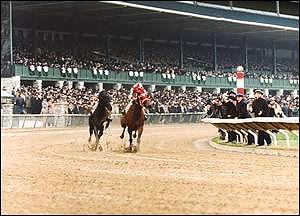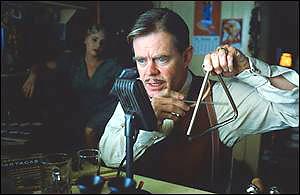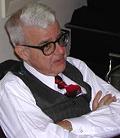On August 2, for the first time in 52 years, I went to a movie that I had seen the day before. The last time I did this, it was The Day the Earth Stood Still, which I actually saw twice on day two, being forced in between showings to suffer a second viewing of Two Dollar Bettor, starring John Litel. The recent movie was Seabiscuit.
 From the opening scene of Seabiscuit, I knew I was seeing a contender. It opens strong, and it finishes ahead by three lengths. While there can always be a dark horse, Seabiscuit is likely to be in the winner’s circle at the Academy Awards next year. (Movie reviewers are unlikely to resist the use of numerous horse racing metaphors, mostly lame.)
From the opening scene of Seabiscuit, I knew I was seeing a contender. It opens strong, and it finishes ahead by three lengths. While there can always be a dark horse, Seabiscuit is likely to be in the winner’s circle at the Academy Awards next year. (Movie reviewers are unlikely to resist the use of numerous horse racing metaphors, mostly lame.)
The opening scene normally would have shouted, “Dud!” When was the last time you saw a movie that was not a dud which opened with an historical voice-over? A decade ago, Tombstone did, but it was a Western, and the narrator was Robert Mitchum, and he didn’t intrude again, once the opening credits were over.
THE NARRATOR
In Seabiscuit, the narrator keeps coming back all through the movie. This has long been the kiss of death, circumstantial evidence that the director gave up trying to fit the jagged scenes into a coherent whole. Even more remarkable, the movie’s scenes are intermittently interrupted by sequences of black-and-white photos from the 1930’s. The narrator then explains the era, with the photos as supporting exhibits. The narrator just won’t shut up. Incredibly, you don’t want him to shut up. That’s because it’s David McCullough, the historical narrator of our generation.
McCullough first narrated his way into our lives in The Civil War, Ken Burns’ incomparably successful PBS documentary, which did not have a single living human being in any historical scene. McCullough has graced other documentaries by Burns, but The Civil War remains their joint masterpiece.
Our generation of sporadically educated Americans sits in front of its TV screens, overwhelmed by sequences of historical images, and cries out, “Tell us what is going on, Mr. McCullough. We are lost.” Then his voice — not imperious, yet not exactly soothing, either — comes on, and we become more calm. Like children on their father’s lap, looking through his scrap book, our generation’s perception of the past gets put back together by his comforting narratives.
David McCullough writes as well as he speaks. There is no more compelling spinner of historical narratives in our day. Anyone who can make John Adams into as lively and even likeable a figure as his wife Abigail was is nothing short of a narrative alchemist, turning lead into at least gold plate. (I say this as a professionally certified though rusty historian.) The only man who could have given McCullough a run for the narrative money in our day is Gore Vidal, who adopted the historical novel instead. Vidal recognized McCullough’s narrative gifts early, in his August 13, 1981 review of McCullough’s book on Theodore Roosevelt’s youth, Mornings on Horseback — a review, sadly, that has been removed from the public Web, now that the New York Review of Books has gone ruthlessly capitalistic and charges money for access to its archives.
THE THEMES
McCullough begins by setting the scene for the movie, a summary of Henry Ford’s incomparable achievement. When Ford began, we are told, his plant could assemble one car in 13 hours. Five years later, it was one car every 90 seconds. Ford’s technique, the conveyor belt-driven production line, was then widely imitated, McCullough says. This changed everything, he says. Well, it really did change everything. It made America into a mass-production society. It made Americans rich. McCullough’s voice-over and the photo images make this truth clear.
Perfect.
The movie begins with automobiles. A contrast is present throughout the movie: the sport of kings vs. the age of the automobile. Seabiscuit’s owner is a highly successful car salesman who had not ridden a horse in two decades in 1933.
The deliberate irony of both the book and the movie is that the common man, empowered as never before by the automobile, supposedly turned for inspiration to horse racing, and one horse in particular, during an era in which, in the immortal phrase of Will Rogers, America became the first nation to go to the poorhouse in an automobile.
The narrative and the dialogue put into the mouth of Seabiscuit’s owner create the image of Seabiscuit as the discarded horse of great lineage, who performed well only late in life, beating the other thoroughbreds. Yes, we are told, he was a thoroughbred, but he would have been the runt of the litter if horses were born in litters. This made him a horse of choice for the common man to cheer.
His owner, Charles Howard, started out as a bicycle repairman-turned salesman whose product was outmoded. A series of half a dozen scenes, spanning at most two days, are brilliantly crafted to tell the story of his transition from a failed bicycle salesman to a rich car dealer. This really is the story of the great age of entrepreneurship: a man with an untried technical skill who sees a better way to do the job, and who gets rich as a result. I have never seen this truth more effectively portrayed on-screen. Its brevity and its subtlety are nothing short of artistry. McCullough’s narrative on Ford and his era had introduced this theme perfectly. The scenes of the young bicycle salesman who finds his calling and makes a fortune confirm the narrative perfectly.
 McCullough’s narrative insists that mass production was the beginning and end of imagination. I have no idea what this means, but I am sure of this much: the director asks the audience to employ imagination on an unprecedented scale. In these scenes, Jeff Bridges, age 53, plays a man of 30, and gets away with it.
McCullough’s narrative insists that mass production was the beginning and end of imagination. I have no idea what this means, but I am sure of this much: the director asks the audience to employ imagination on an unprecedented scale. In these scenes, Jeff Bridges, age 53, plays a man of 30, and gets away with it.
There is another thematic contrast, and it is not particularly subtle. McCullough tells us that in 1900, a common but gifted man could make a huge fortune. The movie shows this through Howard. Then, without warning, we are thrown into 1929 and the stock market crash. This takes place immediately after a speech by Howard on the unlimited potential of the future. This sets the scene for the movie’s rival theme: the Great Depression and the need for hope.
At one point, McCullough’s voice returns and narrates a series of Burns-like photographs of people employed by the New Deal’s tax-funded make-work projects. McCullough identifies this as relief, and it came with many names, he says: CCC, WPA, etc. Relief, he says, demonstrated for the first time in a long time that “someone cared.” But who was this “someone”? The sequence of photos ends with a photo of a common man alongside Franklin D. Roosevelt. Nothing needs to be said for anyone older than Jeff Bridges.
In the high-stakes race for the Academy Award, Seabiscuit at this point rounds the first turn and races ahead by two lengths.
Here is the movie’s main central theme: little guys, creative at their core, yet nonetheless little guys, symbolize America. They challenge the establishment and win. To believe this regarding anything connected with thoroughbred horse racing is the equivalent of believing that Jeff Bridges might possibly be 30. It takes great imagination and a willing suspension of disbelief.
THE PHOTOGRAPHY
The photography is breathtaking. It is quite properly reminiscent of the movie’s sire, The Black Stallion. The scenes of wild horses racing on the Great Plains, the galloping Seabiscuit on various horse farms, the in-pack scenes on the race tracks are simply spectacular. The pounding of the hooves put us in the middle of the races. Again, The Black Stallion is the obvious model.
This movie must be seen on a big screen. Even a large screen, high definition, home entertainment television set will not do it justice, let alone my 1987 20-inch model with the rattling plastic speaker box.
THE MUSIC
Randy Newman is one of a handful of composers who will be remembered in a century as the creators of the only orchestral music of the twentieth century that is worth listening to, other than Aaron Copeland. All of these men have written for Hollywood movies. Think of Jerry Goldsmith (Star Trek, Patton) and John Williams (Star Wars). Would anyone residing outside of New York City’s Upper East Side openly admit that he prefers to listen to Igor Stravinsky or John Cage? Really?
Newman not only wrote the film’s orchestral music, he assembled a series of unexpected overlays for some of the early race scenes. The first race features a powerful, fiddle-centered country music band. The speed and power of racing are emphasized by the music. In a later race, he selected a bluegrass band that I cannot identify playing a song that I have never heard, and it works. As Seabiscuit’s story develops and the tension builds, Newman superimposes good, old-fashioned majestic Hollywood orchestral music over the races. It works. It all works.
One of the early secrets of the success of American movies was the fusion of music with visual images. As early as King Kong, the music helped shape the movie. Try to imagine O Brother, Where Art Thou? without a sound track. The British caught on earlier than Europe did, but it took them decades. How many French movies in the 1960’s had some gangster car chase scene, with light jazz as the background? I could provide an accurate estimate if I went to a French movie more than once every thirty years. (The French are a nation of self-proclaimed aesthetes who think Jerry Lewis is hilarious.)
 THE ACTING
THE ACTING
There is not one bad performance, not one miscast actor or actress. But William H. Macy, once again, proves that he is the scene thief of our generation. It is a thing of wonder to behold. He comes on-screen, accompanied only by an unnamed, rarely speaking blonde, and deftly picks the collective pockets of the entire cast. He doesn’t do it once; he keeps doing it, scene after scene. I can almost imagine him returning each wallet, now empty, to each of the cast members, who are meekly lined up against the wall. He walks down the line saying, “Thank you. Thank you so much. I really did appreciate this opportunity. Again, thank you.”
The only time when I harbor any doubt that Macy is the greatest on-screen character actor of our day, the top second banana of them all, is when Gary Sinese is on-screen. Then I have no doubt that Sinese is the uncrowned title-holder. Someday, there should be a match race between these two, probably with Tom Hanks as the producer, who will keep most of the gate’s receipts.
If Macy doesn’t get best supporting actor for this role, then Sinese had better have a major role later in the year. Macy is just perfect.
THE IMPERFECTIONS
The first imperfection is chronological. We see the newspaper headlines of the 1929 stock market crash. Then we see scenes of a campground, where the family of the young jockey-to-be Red Pollard now lives. This obviously is 1932 or thereabouts — well into the depression. Pollard’s parents then abandon him. The screen fades. The next image says “six years later.” We see an adult Red Pollard beginning his career as a jockey. Yet six years would make it at least 1938 — the year of Seabiscuit’s great race with War Admiral, at the peak of Pollard’s career. Then, without explanation, the movie takes us to 1933, when Pollard is a journeyman jockey in Mexico. Couldn’t anyone in the script department add?
The second imperfection is the repeated outbursts of both profanity and obscenity by Pollard. This was not necessary for the script. But it was necessary for the producers and script writers, who shape public sensibilities by constantly assaulting public standards, decade after decade. “Jesus Christ” is a repeated expletive on Hollywood’s screens. Yet, in a way, these artistic masters of the celluloid universe can assault the Christian West’s definition of profanity only by affirming what they privately deny: that this is in fact profanity. “Thou shalt not take the name of the LORD thy God in vain; for the LORD will not hold him guiltless that taketh his name in vain” (Exodus 20:7).
If America were ever to go Islamic, Hollywood’s producers and performers would not have a hero say on-screen that “Muhammed humped pigs.” Muslims are less tolerant and less pluralistic than Christians. Hollywood’s performers would rather attend the Academy Awards than funerals, especially their own. They are therefore selective in their choice and use of profanity.
It boils down to this, as movie reviewer and Orthodox Jew Michael Medved has said so forcefully: It’s Hollywood vs. America and Hollywood vs. Religion. In one scene, Seabiscuit’s owners and crew are in church. The owner and his wife are singing a hymn. The trainer, his assistant, and the jockey aren’t. That isn’t the Bible they’re reading, either. The last words of the movie are the jockey’s voice-over. He tells us that the horse and his human associates mutually healed each other. The best I can say for that affirmation of redemption is that, while it gave God no credit, at least it didn’t credit it to Franklin D. Roosevelt.
At one point in the movie, Seabiscuit’s owner tells his wife, “You show me something that’s perfect, and I’ll show you something that’s not.” Hollywood has a war in progress, and this war keeps the industry from producing perfect movies.
But this movie comes close.
THE LOSER
There is only one identifiable loser, Laura Hillenbrand, the book‘s author, who somehow came to the conclusion that the story of Seabiscuit needed re-telling, and who told it well. She is a true literary entrepreneur. But she suffers from Chronic Fatigue Syndrome. Today, she is so sick that she does not grant interviews.
Chronic Fatigue Syndrome turned my wife into a pain-ridden semi-invalid in 1987. She was cured in 1988 by a week of treatments on an electronic machine. Actor James Coburn experienced similar deliverance from the arthritis that had crippled his hands and his career. Subsequently, both the inventor and his machine were forced out of the United States by the U.S. government, a story I have told previously on this Web site. Today, with only a few working machines remaining in the possession of the inventor’s lone successor, one woman quietly and without fanfare treats desperate people like Mrs. Hillenbrand. She has only one requirement: that they do not go public about the means of their deliverance.
Henry Ford’s innovation of mass production has been coercively re-directed by the same government that the narrator of Seabiscuit tells us became the agency that cared during the Great Depression. Were it not for that caring bureaucratic friend, Mrs. Hillenbrand could probably buy one of these machines for a few hundred dollars — maybe less.
If that day ever arrives, one thing is sure: somewhere on its exterior, there will be a stamp that says “Made in China.” Henry Ford’s innovation lives on in the most unlikely places.
August 4, 2003
 Gary North is the author of Mises on Money. Visit http://www.freebooks.com. For a free subscription to Gary North’s newsletter on gold, click here.
Gary North is the author of Mises on Money. Visit http://www.freebooks.com. For a free subscription to Gary North’s newsletter on gold, click here.
Copyright © 2003 LewRockwell.com



